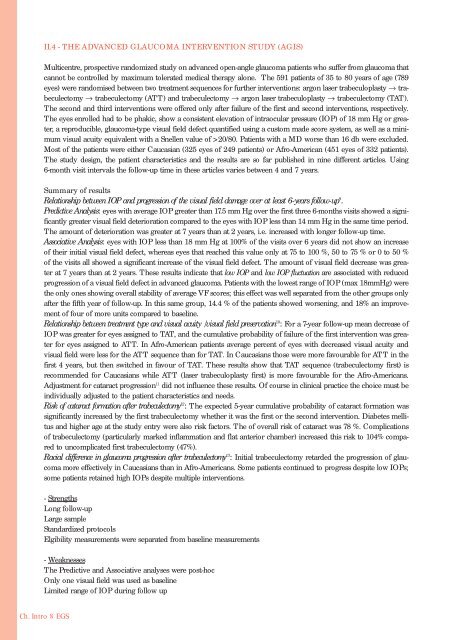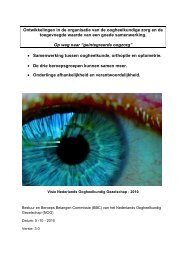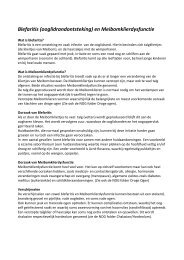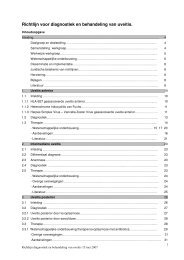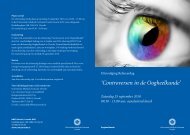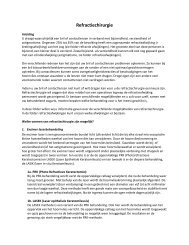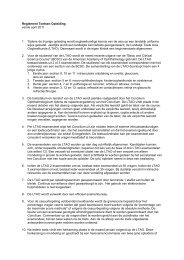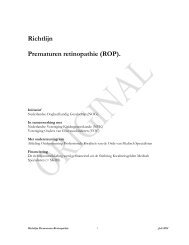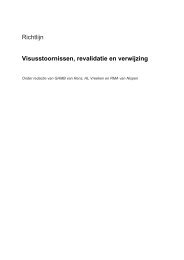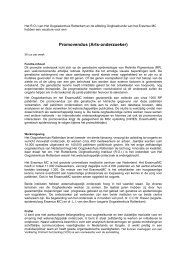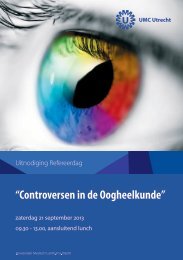terminology and guidelines for glaucoma ii - Kwaliteitskoepel
terminology and guidelines for glaucoma ii - Kwaliteitskoepel
terminology and guidelines for glaucoma ii - Kwaliteitskoepel
You also want an ePaper? Increase the reach of your titles
YUMPU automatically turns print PDFs into web optimized ePapers that Google loves.
II.4 - THE ADVANCED GLAUCOMA INTERVENTION STUDY (AGIS)<br />
Multicentre, prospective r<strong>and</strong>omized study on advanced open-angle <strong>glaucoma</strong> patients who suffer from <strong>glaucoma</strong> that<br />
cannot be controlled by maximum tolerated medical therapy alone. The 591 patients of 35 to 80 years of age (789<br />
eyes) were r<strong>and</strong>omised between two treatment sequences <strong>for</strong> further interventions: argon laser trabeculoplasty → trabeculectomy<br />
→ trabeculectomy (ATT) <strong>and</strong> trabeculectomy → argon laser trabeculoplasty → trabeculectomy (TAT).<br />
The second <strong>and</strong> third interventions were offered only after failure of the first <strong>and</strong> second interventions, respectively.<br />
The eyes enrolled had to be phakic, show a consistent elevation of intraocular pressure (IOP) of 18 mm Hg or greater,<br />
a reproducible, <strong>glaucoma</strong>-type visual field defect quantified using a custom made score system, as well as a minimum<br />
visual acuity equivalent with a Snellen value of >20/80. Patients with a MD worse than 16 db were excluded.<br />
Most of the patients were either Caucasian (325 eyes of 249 patients) or Afro-American (451 eyes of 332 patients).<br />
The study design, the patient characteristics <strong>and</strong> the results are so far published in nine different articles. Using<br />
6-month visit intervals the follow-up time in these articles varies between 4 <strong>and</strong> 7 years.<br />
Summary of results<br />
Relationship between IOP <strong>and</strong> progression of the visual field damage over at least 6-years follow-up 9 .<br />
Predictive Analysis: eyes with average IOP greater than 17.5 mm Hg over the first three 6-months visits showed a significantly<br />
greater visual field deterioration compared to the eyes with IOP less than 14 mm Hg in the same time period.<br />
The amount of deterioration was greater at 7 years than at 2 years, i.e. increased with longer follow-up time.<br />
Associative Analysis: eyes with IOP less than 18 mm Hg at 100% of the visits over 6 years did not show an increase<br />
of their initial visual field defect, whereas eyes that reached this value only at 75 to 100 %, 50 to 75 % or 0 to 50 %<br />
of the visits all showed a significant increase of the visual field defect. The amount of visual field decrease was greater<br />
at 7 years than at 2 years. These results indicate that low IOP <strong>and</strong> low IOP fluctuation are associated with reduced<br />
progression of a visual field defect in advanced <strong>glaucoma</strong>. Patients with the lowest range of IOP (max 18mmHg) were<br />
the only ones showing overall stability of average VF scores; this effect was well separated from the other groups only<br />
after the fifth year of follow-up. In this same group, 14.4 % of the patients showed worsening, <strong>and</strong> 18% an improvement<br />
of four of more units compared to baseline.<br />
Relationship between treatment type <strong>and</strong> visual acuity /visual field preservation 10 : For a 7-year follow-up mean decrease of<br />
IOP was greater <strong>for</strong> eyes assigned to TAT, <strong>and</strong> the cumulative probability of failure of the first intervention was greater<br />
<strong>for</strong> eyes assigned to ATT. In Afro-American patients average percent of eyes with decreased visual acuity <strong>and</strong><br />
visual field were less <strong>for</strong> the ATT sequence than <strong>for</strong> TAT. In Caucasians those were more favourable <strong>for</strong> ATT in the<br />
first 4 years, but then switched in favour of TAT. These results show that TAT sequence (trabeculectomy first) is<br />
recommended <strong>for</strong> Caucasians while ATT (laser trabeculoplasty first) is more favourable <strong>for</strong> the Afro-Americans.<br />
Adjustment <strong>for</strong> cataract progression 11 did not influence these results. Of course in clinical practice the choice must be<br />
individually adjusted to the patient characteristics <strong>and</strong> needs.<br />
Risk of cataract <strong>for</strong>mation after trabeculectomy 12 : The expected 5-year cumulative probability of cataract <strong>for</strong>mation was<br />
significantly increased by the first trabeculectomy whether it was the first or the second intervention. Diabetes mellitus<br />
<strong>and</strong> higher age at the study entry were also risk factors. The of overall risk of cataract was 78 %. Complications<br />
of trabeculectomy (particularly marked inflammation <strong>and</strong> flat anterior chamber) increased this risk to 104% compared<br />
to uncomplicated first trabeculectomy (47%).<br />
Racial difference in <strong>glaucoma</strong> progression after trabeculectomy 13 : Initial trabeculectomy retarded the progression of <strong>glaucoma</strong><br />
more effectively in Caucasians than in Afro-Americans. Some patients continued to progress despite low IOPs;<br />
some patients retained high IOPs despite multiple interventions.<br />
- Strengths<br />
Long follow-up<br />
Large sample<br />
St<strong>and</strong>ardized protocols<br />
Elgibility measurements were separated from baseline measurements<br />
- Weaknesses<br />
The Predictive <strong>and</strong> Associative analyses were post-hoc<br />
Only one visual field was used as baseline<br />
Limited range of IOP during follow up<br />
Ch. Intro 8 EGS


